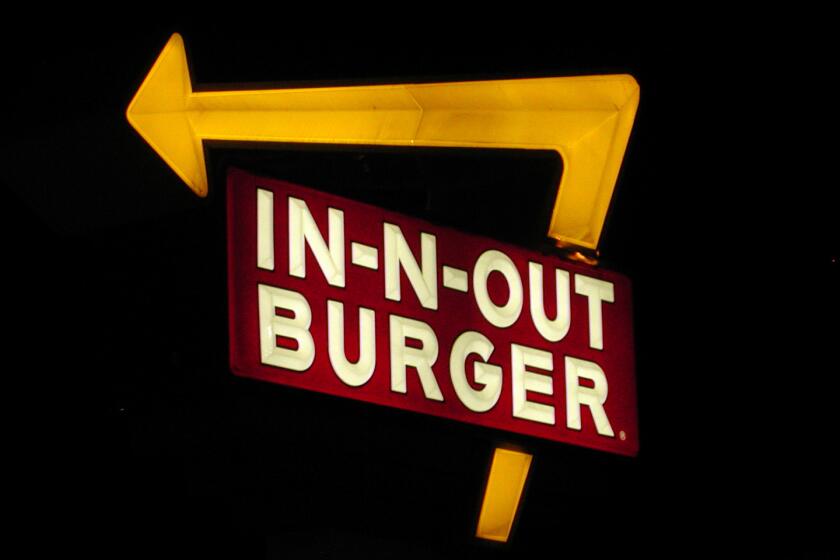Actors find roles as drivers with ride-sharing services
- Share via
By day, Jimmy Lucia is an actor. By night, he roams the streets of Los Angeles as BatLyft.
Cruising in his blue 2013 Kia Rio hatchback, Batman-masked Lucia picks up strangers and takes them wherever they want to go. On a Friday or Saturday night, Lucia will transport as many as 60 people.
But while Lucia’s a nice guy, he doesn’t give them a lift for free. He is one of hundreds of actors, musicians and filmmakers who are making extra cash with their cars by hooking up as drivers with ride-sharing firm Lyft.
“Everybody has a survival job, and some people, like me, are lucky to have a ‘thrival’ job — I can thrive in this job while I pursue my dreams,” Lucia said.
The ride-sharing service is only a year old but already has attracted thousands of customers a week who get around the city in rides by Lyft drivers — usually at a lower price than they would pay for a taxicab. Lyft uses smartphone apps to connect ride-needy users with car-ready drivers.
Lyft and rivals Sidecar and Uber Technologies Inc., which operates the Uber and uberX services, are now in a handful of major cities. The mini-economy they have created is disrupting the established business model of taxicab drivers, who want local officials to crack down on the burgeoning operations.
About 300 cabbies drove in circles around Los Angeles City Hall for about 15 minutes Tuesday morning honking in protest over what they called “high-tech bandit cabs.”
Lyft, Sidecar and Uber ignored an order Monday from the city’s Transportation Department to cease operating because they were violating city ordinances by not having permits or licenses. The firms said they had agreements to operate from the California Public Utilities Commission.
William Rouse, general manager of L.A. Yellow Cab, said he’s outraged about the new companies, especially when they advertise themselves as being 20% cheaper than regular cabs.
Rouse, who also is president of the Taxicab, Limousine & Paratransit Assn., said Lyft, Sidecar and Uber are able to offer lower fares than conventional taxis because they don’t comply with the same regulations that his industry does and their drivers don’t have taxicab licenses.
“We spend a lot of money to comply with regulation,” he said. “We jump through a lot of hoops. So yes, if a company doesn’t have to spend any money complying with regulation, then of course it gives them an unfair competitive advantage.”
Rouse also complained about the lack of inspections and background checks performed by ride-sharing companies on their drivers and their drivers’ cars. And he questioned the adequacy of insurance.
“This is no safer than hitchhiking,” Rouse said. “People don’t hitchhike anymore because hitchhiking is dangerous. If you take one of these services, you’re essentially doing the same thing as hitchhiking.”
Lyft, Uber and Sidecar said they indeed comply with regulations, screen drivers through background checks and make sure that both their drivers and riders are safe. Lyft, for instance, said it has $1-million liability insurance coverage for each incident; drivers also are required to have their own private auto insurance.
The services say they also pre-inspect the drivers’ vehicles, which must be a 2000 model or newer for Lyft and Sidecar and a 2006 model or newer for Uber. Lyft said it may begin to require regular vehicle inspections as the service moves forward, and Uber said it conducts more inspections if it receives feedback that an uberX driver’s car may not be up to standards.
Lyft driver Lucia said he understood the concerns, but he said many riders are turning to Lyft and other services because they feel safer and more comfortable than they do taking other forms of transportation.
“The most common thing I get asked is if I can be personally requested,” Lucia said. “They don’t feel like they’re in some cab. They feel like I’m their friend who’s just continuing the party.”
There isn’t hard data yet on whether these services could become a permanent fixture or fade away, but they are establishing themselves as viable transportation options, said Lauren Setar, lead transportation analyst for research firm IBISWorld Inc.
Because users need smartphones to request a ride, she said, the services are particularly attractive to young and middle-aged users.
“It’s not really using anything that they don’t have,” she said. “It’s using smartphone technology, so it’s something that’s pretty widely adopted.”
With demand growing faster than expected, Lyft said it needs more drivers.
The service kicked off a year ago with dozens of drivers in San Francisco and made its way to Los Angeles in late January with more than 100 drivers. Since then, it has been growing quickly, adding several hundred more drivers in Los Angeles.
In the L.A. area, nearly 60% of Lyft’s drivers are in show business. Sidecar said it estimates that as many as half of its drivers work in the entertainment industry.
Show-business professionals said they like the ride-sharing services for giving them the flexibility they need for their Hollywood careers. On Lyft, drivers can make their own schedules.
“Oftentimes, when I get an audition notice, I get it the night before, and if that audition fell on hours that I was working, I could just drop those hours,” Lucia said. “As far as alternatives, you’re either waiting tables or working a night job and not sleeping much.”
Lucia may be one of the flashiest of the new-age cabbies. Along with his Batman mask, he also brings along a Robin mask and an iPad. While he drives, his riders turn the iPad into a makeshift photo booth and snap pictures in the Batman get-up. Lucia later uploads the photos to his Twitter account, @BatLyft, for them to download.
“We thought L.A. was going to be a great market, but we honestly weren’t sure if it was going to be as good as San Francisco,” said Logan Green, a Los Angeles native who co-founded Lyft. But its Los Angeles market is growing at a faster pace its San Francisco operation, he said.
Green, Lyft’s chief executive, attributed his company’s growth to more city residents shifting away from driving cars and, instead, riding bicycles or using public transportation.
Lyft markets itself as “your friend with a car;” rival Uber as “your on-demand private driver.” Sidecar is built on the premise of drivers giving rides to people who are heading in the same direction.
Sidecar’s ride-sharing program fits well with Jennifer Wessner, an intern at an entertainment company.
She was heading home from a party one recent night and decided to log into her Sidecar account to see if anyone needed a ride in the same direction. Sure enough, one of her neighbors was nearby and had requested a Sidecar.
“He knew me, so it was perfect,” she said. “I was going there anyway.”
Ride-sharing services typically give drivers 80% of what customers pay on their smartphones; the companies keep the rest. Since the transactions are done online, drivers can sign in to see who’s calling.
Lyft and Sidecar refer to the ride fees as donations because users can pay as much or as little as they want.
The services suggest how much a rider should donate, but they can give more or less, depending usually on their experience. Customers also can choose not to donate, but that eventually may make it more difficult for them to get rides in the future.
On Lyft, for instance, drivers can set the minimum payment per route that they’ll accept for trips, thus eliminating from their Lyft notices any online requests for rides from those who want to pay less.
Sidecar drivers also can block those who shortchange them. Sidecar, though, stresses that only 1% of its customers don’t donate and that 90% donate the suggested amount or more.
With so many actors involved in the ride-sharing services, customers are finding that it’s another way to meet a potential celebrity.
Sidecar’s Brian Drolet, an actor who has appeared on MTV’s “The Hills” and “Disaster Date” series, said one of his most memorable experiences as a driver came when one of his passengers recognized him from TV. She began yelling, “Oh my God,” and took pictures and even invited him to hang out with her and her friends later.
“The funniest thing was [she] didn’t even see the front of my face,” Drolet said. “I said, ‘How the heck did you recognize me?’ She said ‘I could tell from the side.’”
Actors said they don’t mind the attention and look forward to the ride-sharing gigs because driving customers often gives them an opportunity to talk about their Hollywood projects.
“Sometimes, if I get to be really chatty with people, I’ll show them the trailer in my car and tell them to look out for it,” Drolet said about his upcoming movie, “Dumbbells.”
salvador.rodriguez@latimes.com
Twitter: @sal19
More to Read
Inside the business of entertainment
The Wide Shot brings you news, analysis and insights on everything from streaming wars to production — and what it all means for the future.
You may occasionally receive promotional content from the Los Angeles Times.











